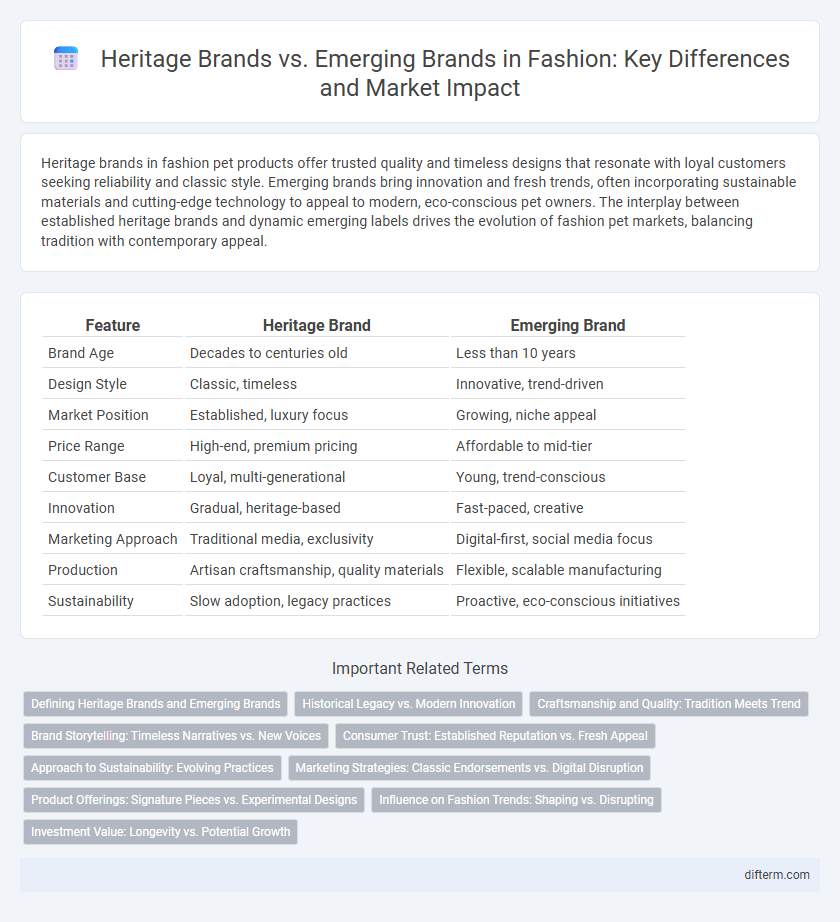Heritage brands in fashion pet products offer trusted quality and timeless designs that resonate with loyal customers seeking reliability and classic style. Emerging brands bring innovation and fresh trends, often incorporating sustainable materials and cutting-edge technology to appeal to modern, eco-conscious pet owners. The interplay between established heritage brands and dynamic emerging labels drives the evolution of fashion pet markets, balancing tradition with contemporary appeal.
Table of Comparison
| Feature | Heritage Brand | Emerging Brand |
|---|---|---|
| Brand Age | Decades to centuries old | Less than 10 years |
| Design Style | Classic, timeless | Innovative, trend-driven |
| Market Position | Established, luxury focus | Growing, niche appeal |
| Price Range | High-end, premium pricing | Affordable to mid-tier |
| Customer Base | Loyal, multi-generational | Young, trend-conscious |
| Innovation | Gradual, heritage-based | Fast-paced, creative |
| Marketing Approach | Traditional media, exclusivity | Digital-first, social media focus |
| Production | Artisan craftsmanship, quality materials | Flexible, scalable manufacturing |
| Sustainability | Slow adoption, legacy practices | Proactive, eco-conscious initiatives |
Defining Heritage Brands and Emerging Brands
Heritage brands in fashion are established labels with a rich history, often spanning decades, known for their timeless craftsmanship, iconic designs, and consistent quality that evokes trust and loyalty among consumers. Emerging brands are newer market entrants characterized by innovative aesthetics, experimental approaches, and a focus on sustainability or niche markets, attracting a younger, trend-conscious audience. The distinction lies in heritage brands leveraging legacy and tradition, while emerging brands emphasize modernity and disruption in the fashion industry.
Historical Legacy vs. Modern Innovation
Heritage brands leverage decades or even centuries of craftsmanship, cultural significance, and iconic design to create timeless fashion pieces that appeal to loyal customers and collectors. Emerging brands prioritize modern innovation by integrating cutting-edge technology, sustainable materials, and contemporary aesthetics to capture the attention of younger, trend-conscious consumers. This dynamic showcases a balance between preserving historical legacy and driving forward-thinking creativity within the fashion industry.
Craftsmanship and Quality: Tradition Meets Trend
Heritage brands excel in craftsmanship by preserving time-honored techniques and using premium materials that reflect decades of expertise and commitment to quality. Emerging brands leverage innovative methods and contemporary designs to reinterpret traditional craftsmanship, creating unique pieces that resonate with modern consumers. This fusion of tradition and trend ensures unparalleled quality while pushing the boundaries of style and creativity in the fashion industry.
Brand Storytelling: Timeless Narratives vs. New Voices
Heritage brands leverage decades of rich history and craftsmanship to craft timeless narratives that resonate with loyal customers and underscore authenticity. Emerging brands introduce fresh perspectives and innovative storytelling, capturing contemporary cultural movements and appealing to younger, trend-driven audiences. Both approaches use brand storytelling strategically to build emotional connections and differentiate themselves in a competitive fashion market.
Consumer Trust: Established Reputation vs. Fresh Appeal
Heritage brands benefit from decades of proven quality and consistent customer satisfaction, fostering deep consumer trust through established reputations and reliability. Emerging brands often attract younger audiences by offering innovative designs and authentic storytelling that resonate with contemporary values and fresh appeal. Consumer decisions increasingly balance the comfort of trusted heritage labels with the excitement of novel, emerging brands that reflect modern trends and individual identity.
Approach to Sustainability: Evolving Practices
Heritage brands prioritize long-term sustainability through established supply chain transparency and investment in eco-friendly materials, often leveraging decades of craftsmanship to reduce waste. Emerging brands adopt innovative practices by integrating circular fashion models and utilizing cutting-edge biodegradable fabrics, targeting environmentally conscious consumers from the outset. Both approaches reflect an evolving commitment to sustainability, with heritage brands blending tradition and modernity, while emerging brands emphasize groundbreaking solutions and agility.
Marketing Strategies: Classic Endorsements vs. Digital Disruption
Heritage brands leverage timeless marketing strategies such as celebrity endorsements and legacy storytelling to maintain loyalty and reinforce their established identity. Emerging brands prioritize digital disruption through influencer collaborations, social media campaigns, and data-driven personalization to capture younger, tech-savvy audiences. Combining classic endorsements with innovative digital tactics creates a dynamic marketing balance that drives both brand heritage and modern relevance.
Product Offerings: Signature Pieces vs. Experimental Designs
Heritage brands emphasize signature pieces that reflect timeless craftsmanship, iconic silhouettes, and well-established quality standards, ensuring brand loyalty and consistent consumer recognition. Emerging brands prioritize experimental designs by incorporating innovative materials, avant-garde aesthetics, and contemporary trends that challenge traditional fashion norms. These contrasting product offerings highlight heritage brands' commitment to tradition and emerging brands' focus on creativity and market disruption.
Influence on Fashion Trends: Shaping vs. Disrupting
Heritage brands shape fashion trends through timeless designs and established reputations, influencing consumer trust and maintaining consistency in style evolution. Emerging brands disrupt fashion norms by introducing bold innovations, experimental aesthetics, and fresh cultural narratives that challenge traditional frameworks. The dynamic interplay between heritage stability and emerging innovation drives the continuous transformation of the global fashion landscape.
Investment Value: Longevity vs. Potential Growth
Heritage brands offer investment value through their established market presence, proven longevity, and loyal customer base, ensuring consistent returns over time. Emerging brands present potential growth opportunities by tapping into new trends, innovative designs, and niche markets, attracting investors seeking high-risk, high-reward prospects. Evaluating investment in fashion requires balancing the stability of heritage labels with the dynamic expansion potential of emerging designers.
heritage brand vs emerging brand Infographic

 difterm.com
difterm.com